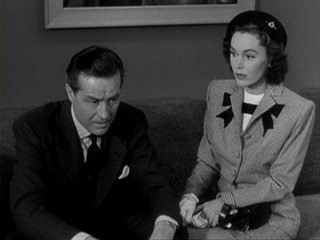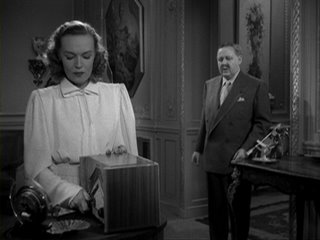The film stars Ray Milland as George Stroud, the editor of a crime magazine. Stroud is happily married, although he hasn’t been able to shake loose from work to go on a honeymoon yet. When we meet his boss, we understand why. The magazine mogul Earl Janoth (Charles Laughton) is a man who likes to be in control, and micromanages his life right down to the minute. This fact is given to us before we even lay eyes on Janoth. A tour group is asking questions about Janoth’s clock tower, and someone asks what happens when the clock stops. Stroud overhears and replies:
“Mr. Janoth would never allow that to happen.”
The film opens with the often-used trick of dropping us into the story and then looping back to tell us how we got there. In this case, Stroud is hiding out in the darkened corridors of the Janoth skyscraper. His voice-over wonders how he got here in just 36 hours, and the camera finds a calendar/clock on the wall – and dissolves to three days earlier. It’s corny but effective, and is completely in keeping with the clock theme of the film.

Janoth is visited early in the film by his mistress Pauline, and he is furious with her for using his private elevator to come up to his office. You see, it’s HIS elevator, and he can’t have someone else using it after he’s told her not to. She is clearly not happy with him, either, and says so.
Pauline soon finds herself sitting next to Stroud at a bar. She knows who he is, and the two of them talk about their common ground – Janoth. This scene is simply a set-up, but it establishes a bit about Stroud. Pauline is clearly flirting with him, and although he tells her that he is happily married, he doesn’t discourage her. He even agrees to an impromptu palm reading, and this is what is going on when his wife Georgette (Maureen O’Sullivan) walks into the bar. So, we see that Stroud is a quintessential Noir male – He should know better, but what the Hell.
The chill that Stroud got from his wife in the bar is amplified when Janoth then wants him to cancel his vacation to follow up on a hot story that is in the works. Stroud is having none of that, because this vacation was going to be the aforementioned honeymoon. He threatens to quit.
Stroud then gets a call in his office from a “palm reader”, and accepts an invitation for a drink from Pauline. Again, he does something that he must know is unwise. This time the one drink turns into several, and leads to a drunken search for a green clock and the purchase of a painting. Stroud wakes up the next morning on Paulines’ couch, having missed his vacation flight with his wife. The drunken binge has clearly not ended with sex, but what it has done is establish a trail, which will fuel the films brilliant corkscrew plot.

Pauline has to rush Stroud out the door when see sees Janoth coming, and the two men see each other in the hallway, although Janoth can’t tell who the other man is. He does, however, know that he came from Pauline’s apartment, and this leads to a violent confrontation between Janoth and Pauline. He rages on her for her sexual dalliances, and she turns it back to him
“Look at you!!!! Who would have you??”
The camera zooms to Laughton’s face as she screams at him, and the suggestion that he is physically unworthy causes him to snap. He kills her with a sundial bought by Stroud the night before.
Laughton is a marvel in this film, as he was in most of his films. Janoth is a man who wants to control things, and his obsession takes extreme forms. He has a man’s pay docked for leaving a light on. At a board meeting he says, “You have one minute to tell me how to get 50,000 new subscribers.” This man has a clock for a heart and would happily admit to it. The thing that sends him into a murderous rage is the suggestion that his sexual machinery is sub-par.
Now we come to where “TBC” really soars – The cat-and-mouse game between Janoth and Stroud. To recap – Stroud has spent the night with Janoth’s mistress. Janoth knows that someone has spent the night but not who. Janoth has killed the mistress. Stroud doesn’t know that she is dead. Janoth puts Stroud of his crime magazine on the path of the mystery man. This plot is brilliantly conceived, with the two men maneuvering right in plain sight of each other. I think that the ultimate compliment is this: It’s complicated, yet easy to follow.
The great Film Noirs were often characterized by a mood created through cinematography and set design, and this one is no exception. It was lensed by John Seitz, whose resume includes The Lost Weekend and Sunset Boulevard, and he has a great palette here. The Janoth building is one of the great locations, and the camera gives it a cold, impersonal feel, lingering on its hard right angles and sterile marble hallways.
If you haven’t seen the movie, I won’t spoil it for you, except to say that all the plot threads come together in a terrific manhunt through the Janoth building, and we come back full circle to where we started the film. Just like a clock.
No comments:
Post a Comment